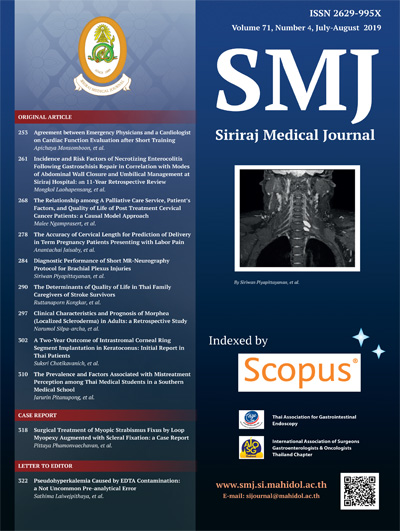A Two-Year Outcome of Intrastromal Corneal Ring Segment Implantation in Keratoconus: Initial Report in Thai Patients
Keywords:
Intrastromal corneal ring segment; keratoconus; ThailandAbstract
Objective: To determine two-year outcome of intrastromal corneal ring segment (ICRS) implantation in keratoconus in Thai patients
Methods: A retrospective review of medical records of the patients underwent Ferrara-type ICRS implantation (single and two segments) at Siriraj Hospital between November 2013 and December 2017 was conducted. Clinical outcomes were assessed at 1 month, 6 months, 1 year, and 2 years postoperatively.
Results: Of 9 eyes in 8 patients, the mean age of the patients was 24.6 ± 7.5 years. The mean follow-up time was 32.2 ± 9.4 months. Overall, the median visual acuity was significantly improved postoperatively (p value = 0.007). At 2 years, the uncorrected visual acuity (UCVA) improved from 1.00 logMAR to 0.56 logMAR, and the corrected
distance visual acuity (CDVA) improved from 0.76 logMAR to 0.10 logMAR. Correspondingly, the median spherical equivalent refraction was significantly improved postoperatively from -7.38 D to -3.13 D (p < 0.001). Moreover, the median anterior corneal topographic data significantly changed between visits (p < 0.02). The Kmax decreased from 52.65 D to 46.65 D and the Kmean decreased from 48.10 D to 45.40 D at 2 years. Postoperative adverse effects were glare and halos (3 eyes), visually insignificant small white corneal deposits around the segments (2 eyes), extrusion of a ring segment needed removal with reversible to baseline vision (1 eye).
Conclusion: This initial report in Thai patients showed that the ICRS implantation in keratoconus could improve the visual, refractive, and topographic parameters with stability at 2 years. However, appropriate case selection and surgical technique should be considered.
Downloads
Published
How to Cite
Issue
Section
License
Authors who publish with this journal agree to the following conditions:
Copyright Transfer
In submitting a manuscript, the authors acknowledge that the work will become the copyrighted property of Siriraj Medical Journal upon publication.
License
Articles are licensed under a Creative Commons Attribution-NonCommercial-NoDerivatives 4.0 International License (CC BY-NC-ND 4.0). This license allows for the sharing of the work for non-commercial purposes with proper attribution to the authors and the journal. However, it does not permit modifications or the creation of derivative works.
Sharing and Access
Authors are encouraged to share their article on their personal or institutional websites and through other non-commercial platforms. Doing so can increase readership and citations.











